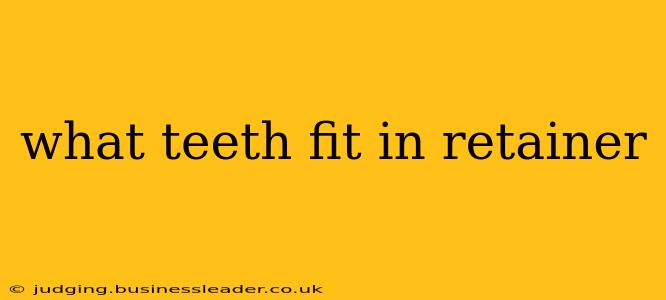What Teeth Fit in a Retainer?
This question is a bit tricky because it depends entirely on the type of retainer you have. Retainers are custom-made appliances designed to hold your teeth in their new, corrected positions after orthodontic treatment (like braces or Invisalign). Therefore, only the teeth that were moved during your orthodontic treatment will be specifically engaged by your retainer.
Let's break down the different types of retainers and which teeth they typically fit:
What Teeth Does a Hawley Retainer Fit?
Hawley retainers are the classic wire-and-acrylic retainers. They typically cover the palate (roof of the mouth) and have a wire that wraps around the front teeth (incisors and canines). While they don't directly "fit" the back teeth, the pressure exerted on the front teeth helps maintain the overall arch shape and alignment, indirectly influencing the position of the back teeth. The extent of coverage can vary depending on your individual needs.
What Teeth Does a Clear (Essix/Invisible) Retainer Fit?
These retainers are made of clear plastic and are molded to fit snugly over your entire arch of teeth, including both the upper and lower. Therefore, all your upper and lower teeth, from incisors to molars, will fit within this type of retainer. This design provides comprehensive coverage and stability.
What Teeth Does a Bonded Retainer Fit?
Bonded retainers are thin wires that are cemented to the inside surface of your lower front teeth. These retainers are designed to prevent relapse of those specific teeth, primarily the incisors and occasionally the canines. The wire will not fit over your upper teeth or any other teeth besides those bonded.
What if My Teeth Don't Seem to Fit in My Retainer?
If you find that your teeth don't seem to fit properly in your retainer, do not force it. This can damage the retainer or even injure your teeth and gums. Contact your orthodontist immediately. There could be several reasons for this:
- Relapse: Your teeth may have shifted slightly, requiring an adjustment.
- Damage to the Retainer: Your retainer might be broken or warped.
- Improper Fit from the Start: In rare cases, the retainer may not have been made correctly.
How Often Should I Wear My Retainer?
The frequency of retainer wear depends on your individual case and your orthodontist's instructions. It’s crucial to follow your orthodontist's recommendations precisely to maintain the results of your orthodontic treatment. Neglecting to wear your retainer as directed significantly increases the risk of teeth shifting back to their original positions.
What Happens If I Don't Wear My Retainer?
Failing to wear your retainer as prescribed can lead to teeth shifting back to their pre-treatment positions (relapse). This can negate the results of your orthodontic treatment, requiring further corrective measures.
Remember to always consult your orthodontist for any questions or concerns about your retainer and its proper fit. They can provide the most accurate and personalized advice based on your specific treatment.
